Everyday Mathematics 1st Grade Answer Key Unit 9 Two-Digit Addition and Subtraction and Review
Everyday Mathematics Grade 1 Home Link 9.1 Answers
Reviewing Measurement
Family Note
Today your child reviewed measurement ideas learned in first grade. Children measured length in paper clips, then made rulers with paper clips as the units. Work with your child to select and measure items around the home using the paper-clip ruler. Please make sure your child brings his or her ruler back to class, as it will be used again.
Find 5 paths or objects in your home to measure with your paper-clip ruler.
Question 1.
I measured ___________.
It is about ______ paper-clip units long.
Answer:
I measured a pencil
It is about 8 paper-clip units long.
Exaplanation:
I took a pencil at my home and measured it with the paper clip ruler by placing the ruler beside the pencil and it is about 8 paper clips long.
Question 2.
I measured ___________.
It is about ______ paper-clip units long.
Answer:
I measured a spoon.
It is about 5 paper-clip units long.
Explanation:
I took a spoon from kitchen, i measured it with the paper clip ruler by placing the ruler beside the spoon and i found that the spoon is 5 paper clip units long.
Question 3.
I measured ___________.
It is about ______ paper-clip units long.
Answer:
I measured a telivision remote.
It is about 9 paper-clip units long.
Explanation:
I took a telivision remote, i measured it with the paper clip ruler by placing the ruler beside the remote and i found that the remote is 9 paper clip units long.
Question 4.
I measured ___________.
It is about ______ paper-clip units long.
Answer:
I measured a pen.
It is about 8 paper-clip units long.
Explanation:
I took a pen, i measured it with the paper clip ruler by placing the ruler beside the pen and i found that the pen is 8 paper clip units long.
Question 5.
I measured ___________.
It is about ______ paper-clip units long.
Answer:
I measured a cup.
It is about 3 paper-clip units long.
Explanation:
I took a cup, i measured it with the paper clip ruler by placing the ruler beside the cup and i found that the cup is 3 paper clip units long.
Practice
Question 6.
Write <, >, or =.
15 ______ 51
80 ______ 80
49 ______ 44
16 ______ 106
Answer:
15 < 51
80 = 80
49 > 44
16 < 106
Explanation:
The number 15 is less than 51,
The number 80 is equal to 80,
The number 49 is greater than 44,
The number 16 is less than 106.
Everyday Math Grade 1 Home Link 9.2 Answer Key
2-Digit Number Stories
Family Note
Today your child practiced adding and subtracting 2-digit numbers by pretending to shop at a school store.
Sample Story

I bought a ball and an eraser. I paid 52 ¢. Number model: 35¢ + 17¢ = 52¢
Question 1.
Think of two things to buy. Draw a picture and write a number story about buying them. Use the back of the page if needed. Then write a number model.
Number model: ___________
Answer:
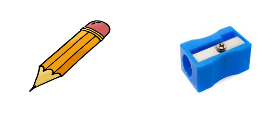
Pencil 28¢ Sharpener 18¢
Explanation:
I bought a pencil and a sharpener,
I paid 46¢.
Number model: 28¢ + 18¢ = 46¢.
Practice
Question 2.
Record the time.

______ : _______
Answer:
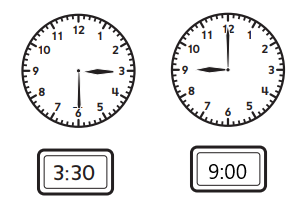
Explanation:
In the first clock I recorded the time 3:30 in the given clock by pointing the hours hand towards 3 amd the minutes hand towards 6 which means 30 minutes.
The second clock shows the time 9:00.I wrote the time in the box below the clock as the hours hand is pointing towards 9 and the minutes hand towards 12 which tells that the time is 9:00.
Everyday Mathematics Grade 1 Home Link 9.3 Answers
Shopping for School Supplies
Family Note
Today your child practiced explaining solution strategies clearly. Clear explanations make sense to the listener and include all of the steps used to solve the problem. For example, “I started at 21 and counted up,” would not be a clear explanation for how a child added 21 and 7. An example of a clear explanation would be, “I started at 21. Then I counted up 7. I ended at 28. So, 21 + 7 = 28.”
After your child solves the problem below, ask him or her to explain the strategy used. Ask questions to encourage your child to explain the strategy clearly.
Question 1.
You bought these items at the school store. How much did you pay in all?
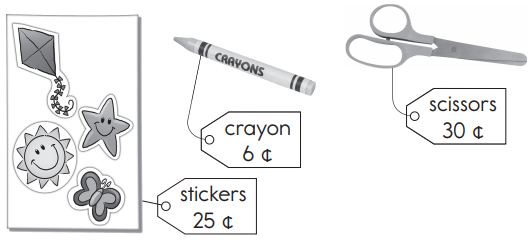
I paid _________ cents.
Explain to someone at home how you solved the problem.
Answer:
I paid 61 cents.
Explanation:
I bought a pack of stickers, a crayon and a scissors.
The stickers costs 25cents, crayon 6cents and sicssors 30cents.
To find the total amount i paid,
First I started counting at 25. Then I counted up 6. I ended at 31. So, 25 + 6 = 31.
Later I started at 31. Then I counted up 30. I ended at 61. So, 31 + 30 = 61.
Therefore i paid 61 cents in all.
Practice
Question 2.
Solve.
20 = 8 + _______ + 5
17 = 6 + _______ + 7
Answer:
20 = 8 + 7 + 5
Explanation:
I started counting at 8. Then I counted up 5. I ended at 13. So, 8 + 5 = 13.
I started counting at 20. Then i counted down 13. I ended at 7. So, 20-13=7.
Answer:
17 = 6 + 4 + 7
Explanation:
I started counting at 6. Then I counted up 7. I ended at 13. So, 6 + 7 = 13.
I started counting at 17. Then i counted down 13. I ended at 4. So, 17-13=4.
Everyday Math Grade 1 Home Link 9.4 Answer Key
Broken-Calculator Puzzles
Family Note
In one of today’s Exploration activities, your child solved broken-calculator puzzles. In these puzzles children came up with ways to make their calculators display a number, even though an important key was broken. They also divided a rectangle into equal shares, and they conducted a final Facts Inventory about which addition and subtraction facts they know.
Use + and – to solve the broken-calculator puzzles. Use a calculator to check your answers.
Question 1.
Imagine your 3-key is broken. Write at least three ways to show 30.
Answer:
10 + 10 + 10 = 30
20 + 10 = 30
29 + 1 = 30
Explanation:
If my 3-key of calculator is broken the i can show the sum 30 in 3 ways by using the other keys like 0, 1, 2, 9 .I checked my answers in the calculator and i found that the answers are correct.
Question 2.
Imagine your 5-key is broken. Write at least three ways to show 15. Use subtraction in one of the ways.
Answer:
8 + 7 = 15
14 + 1 = 15
16 – 1 = 15
Explanation:
If my 5-key of calculator is broken the i can show the sum 15 in 3 ways by using the other keys like 1, 4, 6, 7, 8 .I checked my answers in the calculator and i found that the answers are correct.
Question 3.
Imagine your 1-key is broken. Write at least three ways to show 18.
Answer:
9 + 9 = 18
20 – 2 = 18
8 + 8 + 2 = 18
Explanation:
If my 1-key of calculator is broken the i can show the sum 18 in 3 ways by using the other keys like 2, 8, 9.I checked my answers in the calculator and i found that the answers are correct.
Practice
Question 4.
Jake has ![]() and
and ![]() . Show one exchange he could make.
. Show one exchange he could make.
Answer:

Explanation:
In the above question it is given that jake has 9 tens and 2 ones,
One exchange he could make is dividing 1 tens into 10 ones.
Now jake has 8 tens and 12 ones.
Everyday Mathematics Grade 1 Home Link 9.5 Answers
Vending Machine Addition and Subtraction
Family Note
Today your child added and subtracted prices of items found in a vending machine. Ask your child to explain how to solve Problems 1 and 2 below. Provide pennies and dimes to help your child model each problem.

Solve.
Question 1.
How much does it cost to buy a pencil and a toy car ?
Answer:
It costs 95¢ to buy a pencil and a toy car.
Explanation:
A pencil costs 30¢ and the toy car costs 65¢ .So, to find the cost of both a pencil and a car,
I started counting at 30. Then I counted up 65. I ended at 95. So, 30 + 65 = 95.
Question 2.
How much does it cost to buy a fruit bar and a ring?
Answer:
It costs 95¢ to buy a fruit bar and a ring.
Explanation:
A fruit bar costs 45¢ and the ring costs 50¢ .So, to find the cost of both fruit bar and a ring,
I started counting at 45. Then I counted up 50. I ended at 95. So, 45 + 50 = 95.
Practice
Question 3.
Put together shapes to make 2 new shapes on the back of this paper. Use a triangle, square, and a half circle.
Answer:
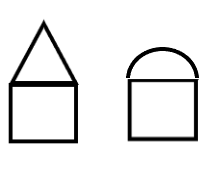
Explanation:
Using the shapes triangle, square and half circle i made the above two shapes.
Everyday Math Grade 1 Home Link 9.6 Answer Key
More 2-Digit Number Stories
Family Note
Today your child solved more vending machine number stories and practiced adding and subtracting 2-digit numbers using a variety of strategies. Your child also wrote number stories and represented them with number models. Provide pennies and dimes for solving the problems below.
Solve the problems and write the number models. Ramona has 44¢. Scott has 26¢. A stamp costs 46¢.
Question 1.
Can Ramona or Scott buy a stamp?
Answer:
No
Explanation:
The stamp costs 46¢ and Ramona has 44¢ and Scott has 26¢.They both have less money than the cost of the stamp.
Ramona and Scott cannot buy the stamp as they dont have enough money to buy.
Question 2.
How much more money does Ramona need? ________ ¢
Number model: ______________
Answer:
Ramona need 2¢ more to buy the stamp
Number model: 44 + 2 = 46¢, 46 – 44 = 2¢.
Explanation:
Ramona has 44¢ as the stamp costs 46¢ i started counting at 46, then counted down 44.I ended at 2. So, 46-44=2¢.
Question 3.
How much more money does Scott need? _________ ¢
Number model: ______________
Answer:
Scott need 20¢ more to buy the stamp
Number model: 26 + 20 = 46¢, 46 – 26 = 20¢.
Explanation:
Scott has 26¢ as the stamp costs 46¢ i started counting at 46, then counted down 26.I ended at 20. So, 46-26=20¢.
Question 4.
How much money do Ramona and Scott have all together? _________ ¢
Number model: ______________
Answer:
Ramona and Scott have all together 70¢
Number model: 44 + 26 = 70¢
Explanation:
Ramona has 44¢ and Scott has 26¢
To find the money both Ramona and Scott have we have to add 44 and 26 So, I started counting at 44, then counted up 26.I ended at 70.So, 44 + 26 = 70¢
Question 5.
If they buy a stamp together, how much money will they have left? _______ ¢
Number model: ______________
Answer:
If they buy a stamp together, the money they will have left is 24¢
Number model: 70 – 46 = 24, 46 + 24 = 70.
Explanation:
Ramona and Scott have all together 70¢ , the stamp costs 46¢ .
To find the money left, i started counting at 70, then counted down 46.I ended at 24. So, 70 – 46 = 24¢.
Practice
Question 6.
Solve.
30 + _______ = 100
67 = _________ + 45
12 + 21 = ________
Answer:
30 + 70 = 100
67 = 22 + 45
12 + 21 = 33
Explanation:
I started counting at 100, then i counted down 30.I ended at 70.So, 30 + 70 = 100
I started counting at 67, then i counted down 45.I ended at 22.So, 67 = 22 + 45
I started counting at 12, then i counted up 21.I ended at 33.So, 12 + 21 = 33.
Everyday Mathematics Grade 1 Home Link 9.7 Answers
Strategies for 2-Digit Addition
Family Note
Today your child continued using various strategies to solve number stories involving adding and subtracting larger numbers. Encourage your child to explain how more than one strategy can be used to solve each of the problems on this page.
Solve.
Write a number model for each story.
Question 1.
Daniel built a tower with blocks. It had 47 cubes and 20 cylinders. How many blocks are in Daniel’s tower? __________ blocks
Number model: _________________
Answer:
Daniel’s tower has 67 blocks
Number model: 47 + 20 = 67
Explanation:
I started counting at 47, then i counted up 20.I ended at 67.So, 47 + 20 = 67.
Question 2.
Carmen used blocks to make a fort. She used 37 cubes and 37 cones. How many blocks are in her fort? __________ blocks
Number model: _________________
Answer:
Carmen’s fort has 74 blocks
Number model: 37 + 37 = 74
Explanation:
I started counting at 37, then i counted up 37.I ended at 74.So, 37 + 37 = 74.
Question 3.
Janet built a tower out of blocks. She used 22 cubes, 26 cylinders, and 10 cones. How many blocks are in Janet’s tower? __________ blocks
Number model: __________ + __________ + __________ = __________
Answer:
Janet’s tower has 58 blocks
Number model: 22 + 26 + 10 = 58
Explanation:
First I started counting at 22, then i counted up 26.I ended at 48.So, 22 + 26 = 48.
Later I started counting at 48, then i counted up 10.I ended at 58.So, 48 + 10 = 58.
Practice
Question 4.
Solve. Use dimes if you like.
90 – 40 = __________
80 – 20 = __________
60 – 30 = __________
70 – 30 = __________
Answer:
90 – 40 = 50
80 – 20 = 60
60 – 30 = 30
70 – 30 = 40
Explanation:
I started counting at 90, then i counted down 40.I ended at 50.So, 90 – 40 = 50
I started counting at 80, then i counted down 20.I ended at 60.So, 80 – 20 = 60
I started counting at 60, then i counted down 30.I ended at 30.So, 60 – 30 = 30
I started counting at 70, then i counted down 30.I ended at 40.So, 90 – 40 = 40.
Everyday Math Grade 1 Home Link 9.8 Answer Key
Review: Relations and Equivalence
Family Note
Today your child reviewed equivalence by determining whether number sentences were true or false. Children also added prices and wrote comparison number models.
Ryan and Janae are choosing things to buy. Circle the group that costs more money.
Write a number model with < or > to compare the prices.
Question 1.

Number model: _________________
Answer:
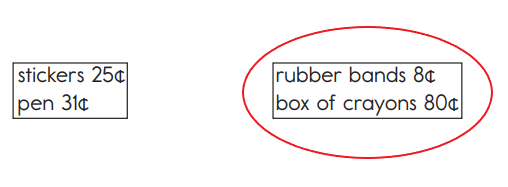
Rubber bands and box of crayons
Number model: 56 < 88.
Explanation:
I circled the group rubberbands and box of crayons
The sum of stickers and pen is 25 + 31 = 56¢
The sum of rubber bands and box of crayons is 8 + 80 = 88¢
I sarted counting at 8, then i counted up 80.I ended at 88.So, 8 + 80 = 88¢
I started counting at 25, then i counted up 31.I ended at 56.So, 25 + 31 = 56¢
56 < 88
Therefore, the circled group has more money.
Question 2.

Number model: _________________
Answer:

Eraser and ball
Number model: 62 < 67.
Explanation:
I circled the group eraser and ball
The sum of money of colored pencil, pen and paperclip is 29 + 31 + 2 = 62¢
The sum of eraser and ball is 17 + 50 = 67¢
First I sarted counting at 29, then i counted up 31.I ended at 60.So, 29 + 31 = 60¢, then I sarted counting at 60, then counted up 2.I ended at 62.So, 60 + 2 = 62¢
I started counting at 17, then i counted up 50.I ended at 67.So, 17 + 50 = 67¢
62 < 67
Therefore, the circled group has more money.
Practice
Question 3.
Jada and Martin cut a pizza in half to share. Then Min and Julius want to share the pizza, too. So they cut the pizza into fourths.
Are the shares now larger or smaller? ___________
Answer:
The shares are now smaller.
Explanation:
If Jada and martin cut a pizza in half to share, their share will be half of pizza but when min and julius want to share pizza they cut the pizza into fourths, now their share will be quarter that is one fourth.
Everyday Mathematics Grade 1 Home Link 9.9 Answers
Review: Home Place Value
Family Note
Today your child reviewed place value. Children also completed number-grid puzzles for 2-digit numbers. Ask your child to explain how to solve each problem below.
Fill in the missing numbers.
Question 1.
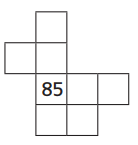
Answer:

Explanation:
I reviewed place value.The 2-digit numbers in 100chart.To complete the number-grid puzzles for 2-digit numbers, we have to count up by 1 to find the mising number to the right of the given number, count down by 1 to find the missing number to the left of the given number,count down by 10 to find the missing number at the top of the given number and count up by 10 to find the missing numbe rtat the bottom of the given number.
Question 2.

Answer:
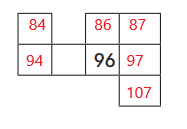
Question 3.
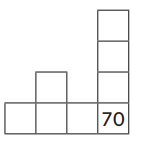
Answer:

Question 4.
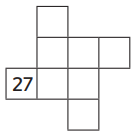
Answer:

Practice
Question 5.
Subtract.
![]() = 8 – 4
= 8 – 4
![]() = 80 – 40
= 80 – 40
9 – 3 = ![]()
90 – 30 = ![]()
Answer:
![]() = 8 – 4
= 8 – 4
![]() = 80 – 40
= 80 – 40
9 – 3 = ![]()
90 – 30 = ![]()
Explanation:
I started counting at 8, then i counted down 4.I ended at 4.So, 8 – 4 = 4
I started counting at 80, then i counted down 40.I ended at 40.So, 80 – 40 = 40
I started counting at 9, then i counted down 3.I ended at 6.So, 9 – 3 = 6
I started counting at 90, then i counted down 30.I ended at 60.So, 90 – 30 = 60
Everyday Math Grade 1 Home Link 9.10 Answer Key
Review: 3-Dimensional Geometry
Family Note
Today your child reviewed attributes of 3-dimensional shapes. Ask your child to point out objects of various shapes around your home or outside and name their defining attributes.

Choose from the shapes above. Tell which shape is described.
Question 1.
Its faces are all squares. ___________
Answer:
Cube
Explanation:
A cube has 6 faces and all faces of a cube are square faces.
Question 2.
It has exactly two flat faces. __________
Answer:
Cylinder
Explanation:
A cylinder has 2 flat faces and 1 curved face.
Question 3.
It has 6 flat faces. ___________
Answer:
Rectangular prism or Cube
Explanation:
A rectangular prism and a cube has 6 flat faces.
Question 4.
Some of its faces are triangles. ____________
Answer:
Pyramid
Explanation:
A pryamid has 5 faces.One is a square and some are triangles.
Question 5.
One or more of its faces is a circle. ____________
Answer:
Cone or Cylinder
Explanation:
A cone has 1 circle face and a cyliner has 2 circle faces.
Practice
Question 6.
Risa has 6 red ribbons, 4 blue ribbons, and 3 purple ribbons.
How many ribbons does she have? ____________
Number model: _______ + _______ + _______ = ________
Answer:
Risa has 13 ribbons in all
Number model: 6 + 4 + 3 = 13
Explanation:
First I sarted counting at 6, then i counted up 4.I ended at 10.So, 6 + 4 = 10, then I sarted counting at 10, then counted up 3.I ended at 10.So, 10 + 3 = 13
Everyday Mathematics Grade 1 Home Link 9.11 Answers
Review: Equal Shares
Family Note
Today your child reviewed dividing rectangles and circles into 2 or 4 equal shares. Children were reminded about the different names for these shares and for the whole. Help your child divide the shapes below and compare the sizes of the shares.
Question 1.
Divide each shape in fourths. Shade 1 fourth.

Answer:

Explanation:
I divided the given shapes into four equal parts by drawing 2 lines and i shaded 1 part of the four parts.
Question 2.
Divide each shape in half. Shade 1 half.
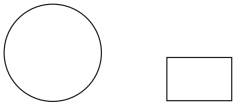
Answer:
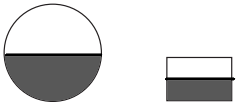
Explanation:
I divided the given shapes into two equal parts by drawing 1 line and i shaded 1 part of the two parts.
Question 3.
Put a check next to the circle with the largest shares. Put a check next to the rectangle with the largest shares.
Answer:

Explanation:
I have marked right that circle and rectangle with the largest share.Th erecatngle in the first question and the circle in the second question has the largest share.
Practice
Question 4.
Solve. Use pennies and dimes to help you.
86 + 10 = _________
_______ = 45 – 10
70 – 50 = _________
Answer:
86 + 10 = 96
35 = 45 – 10
70 – 50 = 20
Explanation:
I started counting at 86, then i counted up 10.I ended at 96.So, 86 + 10 = 96
I started counting at 45, then i counted down 10.I ended at 35.So, 45 – 10 = 35
I started counting at 70, then i counted down 50.I ended at 20.So, 70 – 50 = 20.